JARS v60n4 - The Gardens of Ardkinglas Estate: An Historical Perspective, Part II
The Gardens of Ardkinglas Estate: An
Historical Perspective, Part II
John M. Hammond
Starling, Lancashire, England
In Part I, author John Hammond described the origins and development of Ardkinglas. In Part II, he discusses the Livingston, Callander and Noble Years.
The Livingstone & Callander Years
There is little evidence of any significant changes taking place to the Castle or the designed landscape under the 12th Laird or his successor in 1771, another Sir James Livingstone who changed his name to Campbell and became the 13th Laird. Major changes began to take place when Sir Alexander Livingstone became the 14th Laird in 1778 and Robert Adam, who had drawn schemes for Inveraray Castle in 1773, was requested to draw up sketch plans for country house to replace the Castle, but the plans were not implemented. In 1790 another famous architect, James Playfair, was asked to produce plans for a country house near the site of the old Castle and an amended design was drawn the following year in liaison with Sir Alexander Campbell and completed in 1795. Ardkinglas House was described as "a classical house of three storeys above a basement..."; it contained 66 windows according to the records for Window Tax. Playfair is also attributed with the design of the nearby stable block.
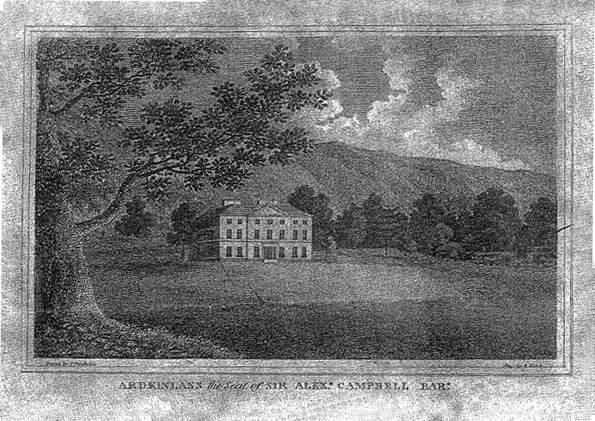
|
|
Ardkinglas, the seat of Sir Alex
Campbell, in approximately 1800.
Photo courtesy of the Ardkinglas Estate. |
The parklands were laid out at this time to the north and south of the House as part of the designed landscape. Many past publications have suggested that the giant silver firs to the north of the Pinetum were planted around 1770 and Alan Mitchell in his 1978 article was of the view that the silver firs and the predominantly beech canopy were planted towards the end of the 18th century.18 The period of development by Sir Alexander would suggest a more realistic date to be 1785-90; but there is other evidence to support this view. By the late-1700s commercial exploitation of Scottish homegrown timber was becoming evident through advertisements placed in the Edinburgh newspapers, among which for November 1789 at Ardkinglas oak, ash, elm, plane, beech, chestnut, walnut, spruce, Scotch fir, etc., of great age and size were up for sale. This would suggest that clearance work was underway to create the parkland and setting for the new house.
In 1881 Thomas Wilkie, the Forester at Ardkinglas, notes in an article written for the Scottish Arboricultural Society that there were a total of 27 silver firs of special mention on the Estate, of which one was much younger than the others, whereas he says the oaks were mostly of about 155 years and a few handsome specimens were growing near the mansionhouse. 19 This suggests that the oaks were planted in around 1725 which fits in well with the period in which Sir James Campbell, 11th Laird, initiated the development of the Estate. Heading this article is the motto that surrounds the motif of the Scottish Arboricultural Society, which is most appropriate in regard to Ardkinglas and a pertinent reminder to all who involve themselves in landscaping and planting up gardens. The horticultural significance of the arboricultural history of the Estate is a subject in its own right and, whilst the presence of the big trees in the gardens cannot be ignored, this article covers only those aspects that relate to the wider historical perspective. Those readers with an interest in forestry are recommended to read the article by David Gray that provides a good introduction and some useful references. 20

|
|
In the lower part of the
Woodland Garden there are many large specimen plants
and trees that thrive in the deep layer of silt washed down from the sides of the glen. On the left, beneath this good form of R. augustinii , is Alan Anderson whose name many members will recognise as a long-time supporter of the ARS Seed Exchange; on the right is Ian Douglas, Past President of the Scottish Chapter. Photo by John M. Hammond |
Around 1792-95, the period that the new House was constructed, an artificial lake was excavated between the Walled Garden and the Loch, this taking the name of the "Caspian," being shaped like its namesake Sea. This would have been an immense undertaking at a time when mechanised equipment was not available. The whole area around the lake and the Walled Garden was then planted up as a shrubbery.
Most large estates, at sometime or other, are severely hampered by financial problems, often from the lack of wisdom of the forefathers. And, when this burden is inherited there comes a time when the lands themselves have to be sold; Ardkinglas is no exception. Niall Diarmid Campbell, who later became 10th Duke of Argyll, explains the problems in his letter dated Christmas, 1905: 1
James Campbell (formerly Callander of Craigforth) 15th of Ardkinglas he being the grandson on his mother's side of Helen heiress of Ardkinglas. In his person the Baronetage became extinct although during the whole of his long life he had the inaccurate effrontery to call himself "Sir" to which he as is well proved had no right whatever. He spent nearly all his life abroad owing to his debts which began the great drain on the Estate... His life was most varied and interesting for he visited nearly all the Courts of Europe and he is the only British Subject I feel sure who was present on the great staircase at Versailles when the Paris Mob broke in upon their King Louis XVI and Queen Marie Antoinette and hurried them off to their doom in Paris.
He was a witness to all the memorable scenes of that hideous time but these details are given not in his printed Memoirs which are chiefly Military reminiscences but in his private Note Books. In after years he was held Prisoner of War by Napoleon, his affairs in Scotland getting into a hopeless confusion. He lived a life of the utmost irregularity yet saw the age of 87 and had 4 lawful wives...he was born in 1745...he died in 1831
Dorothy Wordsworth, the poet's sister, noted on her 1822 visit to the Estate that the mansion was half derelict which may have something to do with why it was destroyed by fire in 1831, the same year as James Campbell died. He had become the 15th Laird in 1810, but there are no records to suggest that he returned from his European wanderings to sort out the affairs of the Estate, so no doubt this was the beginning of the Callanders of Ardkinglas earning a certain reputation for eccentricity.
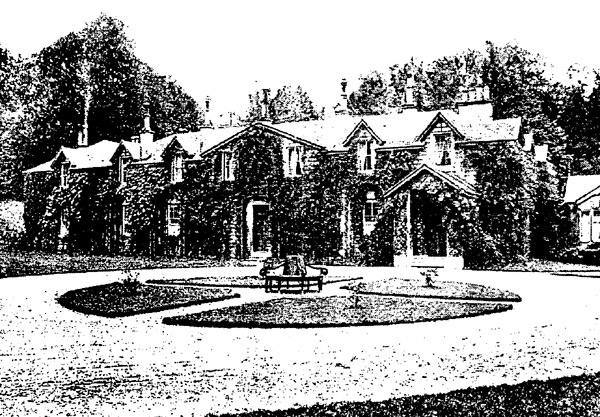
|
|
Ardkinglas Lodge, 1876.
Photo courtesy of the Ardkinglas Estate |
Ardkinglas Estate was significantly in debt in 1831 when James Henry Callander became the 16th Laird and he refused to take the Campbell name. Around 1832, A.M. Binning proposed a scheme for a baronial front, perhaps in connection with rebuilding the House. Presumably this option was too expensive, as under the new Laird's instructions the stable block was converted to serve as the main house and it had "a low central gable and seven bays of dormer windows, which were continued along the side walls." The adapted building became known as "Ardkinglas Lodge" and was in later years referred to as "Old Ardkinglas House." Records lead us to believe that after the 1831 fire all that remained of the mansion was a "pile of stones in the field." Later this became a "depression in the field," but nothing connected with the Campbell Family is as clear-cut as that! Murdo MacDonald, Argyll and Bute Archivist, has drawn attention to a letter written on Saturday, 22nd February 1834 from James Henry Callander to Peter Campbell of Inveraray: 12
How have you been getting on with Dr. Anderson? I hope you are now properly soldered up, and may be able to come on Monday, and see the final catastrophe of the siege. I opened the trenches late yesterday afternoon, and fired six rounds at the pillar between the drawing room windows, in which I effected a breach. In spite of the weather today, I resumed operations, and fired twenty rounds more, and so effectively directed that at least one third of the house is entirely razed. Nothing could be more grander than the fall of the building, after 9 successive shots had been spent cutting a horizontal breach along the centre of the gable at this end close above the little out-wing. The whole Gable end first of all cracked from top to bottom, then gradually swayed and bent until losing its balance, the whole of it came down with the noise of thunder; the main support thus being taken away from the great centre partition which contained the Drawing Room chimney - in a few seconds after the fate of the gable, it also came thundering down to the very foundation. The Six Pounder does its work most admirably, and carries a full service charge (2 lbs. of powder, shot and wad) with perfect good temper: - and now that I know a little more of the mode of making an effectual breach, I shall make the next 20 shots do still more execution than the last.
Now we know how the burnt-out shell of Playfair's mansion was reduced to a pile of stones! And, perhaps the remains were used, like the castle before it, as a quarry for stone for building the replacement house. George Frederick William Callander became the 17th Laird at the age of 3 years in 1851 and the reigning Duke of Argyll became Guardian of all the Ardkinglas children. George was Laird in name only, did not take up the Campbell name and had no interest in running the Estate.
George and his brother Henry were both somewhat eccentric, but were very proficient amateur engineers and in 1866 they supervised the construction of a miniature railway. The Model Railway trackbed is shown on the 1st edition of the 25-inch scale Ordnance Survey map, published 1870, commencing on the Rhubba Mor peninsula, then running past the Caspian Lake, the parkland and terminating at a pier about 400 yards south of the Estate Offices. The Oban Times of 9th October 1875 comments: 12
...model railway nearly a mile in length along the shore of Loch Fyne. Over this miniature line a pygmy engine draws a handsome carriage capable of accommodating two persons. At intervals stations have been erected and the line is worked on the most approved principles, these being on a small scale all the requisites of a large railway system.
In the Dunoon Herald of 1st December 1916 a historical note describes the miniature railway: 12 ...constructed on piles for about a mile along the shore of Loch Fyne. It had a gauge of 18". There was a powerful little locomotive, with engine house, points, signals, railway station all complete.
Model railway engineering, in terms of hand-held small-gauge locomotives and track, dates from 1838, but large-scale miniature garden railways did not come into vogue until the early-1900s. So, the work of the Callander brothers is historically significant and their miniature garden railway is one of the first, if not the first, to be constructed in Britain. By any standards, a track gauge of 18 inches is very large, particularly if compared with the Ravenglass & Eskdale Railway, or the Romney, Hythe & Dymchurch Railway; both are well-known tourist attractions and are engineered on the smaller 15-inch gauge.
From the Estate records it is known that the railway was built in 1866, mainly by William Wallace, a joiner from Cairndow village; whilst the stonework, as required, was carried out by Adam Linton, a mason from Cairndow. The steam engine was probably a simple four-wheeled tank locomotive and it is likely to have been assembled away from Ardkinglas due to the engineering complexities involved, probably at one of the Glasgow or Newcastle workshops.
At this date George Callander would have been 18 years old and it has been suggested that George may well have come under the influence of Arthur Heywood whilst they were both at Eton College. Sir Arthur Heywood, of Duffield Bank, to the north of Derby, became famous for the promotion of 15-inch gauge passenger and freight-carrying miniature railways on country house estates. However, Sir Arthur did not commence his stability experiments on 15-inch gauge equipment at Duffield Bank until 1874, some eight years after the line at Ardkinglas was constructed, and it is more likely that he was influenced by the work of George Callander.
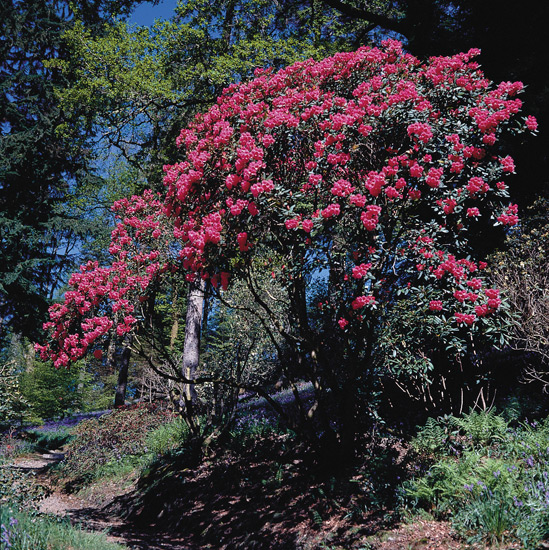
|
|
A magnificent deep pink specimen
of
R. oreodoxa
alongside the path
leading down to the lower part of the Woodland Garden. Photo by John M. Hammond |
According to oral tradition, the railway line and its structures at Ardkinglas were severely damaged on the night of 28th December 1879 by the hurricane that brought about the infamous collapse of the railway viaduct across the Firth of Tay; but by this date George Callander was showing signs of severe mental illness. The remnants are said to have been dismantled in the 1880s; but, sadly, by the early-1890s George Callander was confined to a psychiatric hospital and his railway had gone. However, the engineering expertise of the two brothers extended far beyond miniature railways; they built a fleet of enormous galleons in the style of Nelson's Victory, armed each galleon with miniature cannons that actually fired, and sailed these in battle on the Caspian "sea."
Remnants of these warships and cannons still exist in Ardkinglas House. It is likely that the boathouse and pier at the north end of the Caspian were constructed in the 1860s to enable the warships to be "rescued." Unfortunately, genius in a particular field of endeavour can often extract too high a price at a personal level, and so it appeared to be with the Callander brothers, neither of whom left heirs.
Estate records suggest that the 57-acre Pinetum was established around 1875, although groups of "ornamental" plantings had existed within a 25-acre compartment for the better part of a century. This date fits in well with the notion that the damage caused by the 1879 hurricane would not have been limited to the miniature railway and in reality the storm probably caused significant damage to the woodlands on the Estate. In the absence of a Laird who was able to handle the affairs of the Estate, it would have fallen to the 9th Duke of Argyll to approve any major clearance work, etc., and a review of the overall situation would have been a necessity. Janey Sevilla Callander (1846-1923), daughter of the 16th Laird of Ardkinglas and married to Lord Archibald Campbell (1846-1913), took over the Estate after George Callander was confined to a psychiatric hospital in the early-1890s. Around this date her son, Niall Diarmid Campbell, was appointed Curator of Ardkinglas to look after the affairs of the Estate and the management of the woodlands. Niall kept a sequence of personal notebooks that contain a number of interesting entries, including the following extracts dated October 22nd & 28th, 1901: 13 Told Luke to clear out some of the trees in the Pinetum, in which I found many rare specimens doing splendidly. Several are not at Inveraray at all...Marked out all the trees to be taken out of the Pinetum to let in air and light.
Entries in the notebook made in 1902 indicate that the removal of the trees had made a difference. Niall inherited the Estate from his mother in 1905 and in liaison with the then 9th Duke of Argyll it was decided that the Estate should be sold to clear the debts. 14 Oral tradition has it that a small portion of the Estate records relating to the Campbell, Livingstone and Callander families was removed to the Campbell Family archives at Inveraray Castle at this time and the remaining records were burnt on a large bonfire.
The Early Noble Years
The Argyll roots of the Noble Family date from an ancestor, General John Campbell of Mamore, who was an officer of the Argyll militia and was appointed to command all of the troops and garrisons in the West of Scotland when the 1745 Jacobite Rising broke out. He became 4th Duke of Argyll in 1761. Captain Sir Andrew Noble, Bt., K.C.B., (1831-1915) was an expatriate Scot, who resided at Jesmond Dene House in Newcastle and had been for many decades the business partner of Lord Armstrong, founder of W.G. Armstrong & Co., at Elswick. As chairman he made his fortune from the armaments firm whose tentacles extended along the north bank of the River Tyne. He had a heavy engineering background, with family connections to the iconic engineer Isambard Kingdom Brunel, and as a physicist is credited with developing cordite for use in armaments.
It is probable that Sir Andrew knew of the Campbell Family's decision to sell Ardkinglas and he purchased the bulk of the Estate, 35,000 acres, from the Callander Family in 1905. The Lochgoil part of the Estate was sold to Lord Rowallan of Kilmaurs, Ayrshire.
We have Ardkinglas. Should like to see you tomorrow. Noble.
This is the telegraph message with which Sir Andrew summoned, in peremptory Victorian fashion, his energetic daughter Lilias ("Lily") to make an immediate start on his plans to build a suitably impressive mansion on his Argyllshire Estate, chiefly to please Margery, his Scots-Canadian wife. Margery, of Campbell descent, had always longed to return to Noble territory on Scotland's West Coast. 2 Sir Andrew envisaged the mansion would be his Highland shooting lodge, but Margery and the forceful Lilias had other ideas, persuading Sir Andrew to make Ardkinglas the family's permanent residence. Robert Lorimer (1864-1929), one of the favourite architects of the Edwardian era, was only known at this date for his skilful restoration of old tower houses and had been waiting for the opportunity to build a country house from the ground up for a client to whom expense would be no object. Sir Andrew, an extravagant tycoon, was precisely such a client, but he was a man in a hurry and wanted to see his house finished. Already in his mid-seventies, he gave Lorimer his commission and a remarkably free hand to design, build and furbish the entire house down to the last detail. His brief was simple and straightforward, handed down to Lorimer through his daughter who was to be Sir Andrew's on-site representative:
Nothing but the best and hang the expense - and get on with it! 2
Lorimer responded: This big job I have on Loch Fyne I mean to handle as I've never handled a job before. The ground is to be broken on 1st May (1906) and the dear old gent wants to eat his dinner in it on 1st August 1907. 2
Lorimer took up the challenge, cut no corners and produced what is probably his greatest work. Constructed of local granite of a greenish hue that came from a seam at the loch-side, roofs covered with Caithness slate, weathered the colour of malt whisky; the neo-baronial mansion with its corbelled turrets, stepped gables and breakneck roofs sits naturally in the wooded landscape with an peaceful sense of grace.
Lorimer was gifted in being able to get the best out of his Edinburgh craftsmen, to whom he gave full credit for their workmanship, and together they used their artistic freedom to produce an interior remarkable in its decorative detail, influenced by Scottish Arts & Crafts movement. Its 80 rooms were luxurious, modern in the practical elements of design and, most of all, comfortable. Sir Andrew had a dam, power house and salmon ladder constructed on the fast flowing River Kinglas to supply the Estate with electricity; it was the first hydroelectric plant of its kind to be built in Scotland and the mansion was one of the first country houses in Britain to have electric power. Lorimer designed the stylish light fixtures and these are still in use; that in the Drawing Room is a beautiful work of art by any standards. Astonishingly, Ardkinglas, the last great country house to be built in Scotland was finished on time in 1907 at a cost of £55,000.00. 15
In 1906 Lorimer designed the terrace and formal gardens and these also reflect his attention to detail. 16 From a hidden door in the panelled Drawing Room an S-shaped exterior staircase leads down to the terrace. On the west front is a terrace garden with a pool, and rising from its midst is a leaden mermaid playing with a dolphin that together form a fountainhead. This area is paved and enclosed by a clipped yew hedge. A second S-shaped exterior staircase leads down from the Loggia to the north front terrace that extends to beyond the fountain and the bank is retained by a 5-foot (1.5m) stonewall, topped with a balustrade. No plantings were permitted to mask the view along the upper reaches of Loch Fyne.
At the northeast corner of the terrace a flight of stairs cleverly broadens as it sweeps down to meet the pathways and gardens around the banks of the Caspian lake. Here a path diverges that leads to the Walled Garden with its beautiful intricate wrought-iron entrance gates that are said to be Lorimer's work. Lorimer may well have created the additional area of garden alongside the outer face of the main wall of the Walled Garden, with its central pond and fountain. This became known as the Ladies Garden, as down the years the Ladies of the House seem to have taken an interest in its planting and maintenance. It was originally planted-up with rose beds and herbaceous borders, the Estate having a team of seven gardeners to tend the gardens and supply the "Big House" with flowers, fruit and vegetables. Lorimer also converted part of Ardkinglas Lodge to form the Estate Offices and the remainder was later demolished.
Of particular interest is a letter from the Estate records written by Niall Diarmid Campbell to Miss Lilias Noble, dated "Bartlemas, 1908." Niall had shown Professor Charles Sargent of the Arnold Arboretum, who he says is “the greatest living authority on trees," the big silver fir in the Pinetum. It appears that Sargent said:
It is undeniably the mightiest conifer in Europe if not the biggest bole of any living kind in Europe.
Around 1910 James Boyd & Sons of Paisley constructed the glasshouses to the north of the Walled garden. 17 Their design is unusual, being wrapped around a squash court. Little is documented about the work of James Boyd & Sons; however, initial researches indicate that the company constructed the Great Palm House at the National Botanic Gardens, Glasnevin in 1884, the last remaining system-designed domed glasshouse to be constructed on such a large scale. There will be many glasshouses in Scottish gardens that were of Boyd construction.
Sir Andrew entertained on a lavish scale with endless house parties that fished, shot and stalked "on the hill," thus working-up an appetite for gargantuan meals that were served in both comfort and style. When he died in 1915, the Edwardian tradition of summering in Scotland was swept away by the First World War and life at Ardkinglas would never quite be the same again. On Sir Andrew's death the Estate was left to his three sons jointly, by which time Britain was deeply distracted by the events taking place on the battlefields of Europe. John H.B. Noble (1865-1938), the third son, lived at Sandhoe, near Hexham in Northumberland, and commuted the short distance to the W.G. Armstrong & Co. works at Elswick. He realised that in the post-war climate the management and control of the company would be in different hands so he bought out his brothers' share of the Estate and with the cessation of hostilities in 1918 he came to live at Ardkinglas with his wife Amie (1879-1973) and their five children.
A group of refugees from a Belgian nursery found a home at Sandhoe during WWI with the Noble family and on returning to their homeland in 1918 they sent a large selection of Ghent azaleas direct to Ardkinglas. The gardens had received little maintenance during the war, so Amie cleared out the herbaceous border that ran the length of the Ladies Garden and planted an azalea garden and then used the remainder of the plants to create a border along the base of the terrace wall in front of the House. Amie then turned her attention to the Walled Garden and ordered 36 double-cordon and grid-iron trained apples, in 17 varieties, from Storrie & Storrie of Glencarse, near Perth; these were delivered to Arrochar Station in February, 1921. 2 The following year a consignment of 96 climbing roses were delivered to Arrochar Station by Dobbie & Co. Ltd., followed by 4,500 narcissus, tulip, iris, crocus, anemone, cyclamen and trillium bulbs from Barr & Sons of Covent Garden, London, in 1924. 2 Throughout the 1920s John Robson was Head Gardener and in charge of four under gardeners. His weekly wage of £2. 10s was supplemented by the use of Garden Cottage, an allowance of five tons of coal a year together with potatoes and vegetables when available.
Meanwhile, in the same period John Noble turned his attention to the Pinetum and ordered ten rhododendron species from Sunningdale Nurseries, including R. barbatum , R. calophytum and R. argyrophyllum and these were delivered in December 1922. The following year an order for 104 evergreen plants was placed with The Landowners' Co-operative Forestry Society, Ltd., of Edinburgh and included acers, berberis, malus, prunus, rosa, cornus and rhododendrons; these were delivered in January 1924. Amongst the latter were R. campanulatum , R. maximum , R. adenogynum , R. auriculatum and Forrest No. 14345 ( R. flavorufum ). 2
All of this suggests that here we have a gardener who is intent on creating an under-storey in the Pinetum, so 1922 marks the date of the commencement to create a woodland garden. However, there would have been considerable work involved in clearing the woodland floor, particularly after the downturn in forestry maintenance caused by WWI. Throughout the 1920s Nicol Luke was Head Forester, in charge of three under foresters, and in this period it is likely that he would have been responsible for the Pinetum. His weekly wage of £2. 5s. was supplemented by the use of Post Office cottage and garden, the keep of a cow and follower, an allowance of five tons of coal a year and a supply of potatoes when available. 2
In 1923 John Noble was created Sir John Noble of Ardkinglas and, fittingly, the original area that he planted up in the Pinetum became known as Sir John's Bank. Here the oldest rhododendrons in the garden can be found, including good specimens of R. 'Loder's White' and R. souliei .
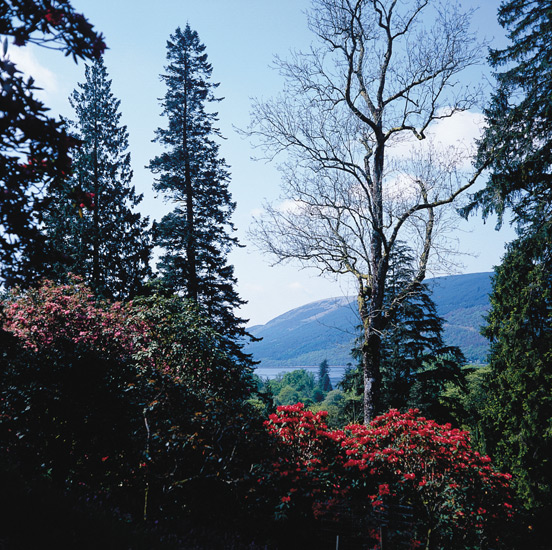
|
|
There are some glorious views
across Loch Fyne from the upper levels of the
Woodland Garden. This area also provides a good vantage point to view the tops of many of the Champion Trees that are a feature of the Woodland Garden. Photo by John M. Hammond |
The Development of the Gardens, Plant Acquisitions and Hybridisation Work of Michael Noble
In 1929 Michael (1913-1984), then 16 years old and the third son of Sir John, began to help his father to plant rhododendrons on Sir John's Bank in the Pinetum. Sir John, encouraged by the good performance of his earlier plantings, sought to increase the scope of his collection.
The Family's friendship with other enthusiasts, among them, Sir Eric Savill of Windsor, Sir James Horlick of Achamore, the Gibson Brothers of Glenarn and Sir George Campbell and his son (now Sir Ilay) of Crarae, led to the acquisition of a wide range of rhododendrons and other evergreen plants. Sir Ilay Campbell, in an obituary he wrote for the R.H.S. Journal in 1984, provides an insight to Lord Glenkinglas's early years: 22
Michael Anthony Christobal Noble was born on 19th March 1913, being the third and youngest son of Sir John and Lady Amie Noble of Ardkinglas...Educated at Eton and Magdalen College, Oxford, he joined the Royal Airforce Volunteer Reserve, with which he served throughout the 1939-45 war, attaining the rank of Squadron Leader. In 1940 he married Anne, daughter of Sir Neville Pearson Bt, and in 1947 they settled at Strone, a delightful and welcoming house on the Ardkinglas estate...
...Michael was already aware of the gardening potential of Argyll's mild moist climate, for Sir John had started to plant rhododendrons in the Ardkinglas Arboretum beneath the vast silver firs, one of which is the tallest tree in Britain. In the late-1920s, encouraged, among others, by a young undergraduate staying nearby called Walter Magor, who saw that it would make an ideal site. Michael, while still a boy, enjoyed nothing better than helping his father with the planting, and thus developed a love of the genus which never left him.
One of his greatest friends, both at school and university, was Charles MacLaren (now Lord Aberconway), whose father, impressed with Michael's knowledge and enthusiasm, sent him two truck loads of plants, many of which still flourish today. They became known in the Family as the "Bodnant Chuck Outs"!
Walter Magor, the "young undergraduate," was the son of E.J.P. Magor of Lamellen, Cornwall, the pioneer rhododendron enthusiast and hybridiser, perhaps better known to many as Mr. Magor. Sometime in the late-1920s Sir John had become a member of the Rhododendron Association and it is likely that Walter Magor had a hand in this. In later years Lady Anne recalled a story about enthusiasm for rhododendrons: 23
I first met Walter Magor on an aerodrome, where he was chatting to my husband; they were talking about rhododendrons. The aerodrome was in Jamaica!
Major Walter Magor confirmed this story. Lord Aberconway (1913-2003), in a letter to David Gray, dated 12th December 1996, explains how the plants came to be sent from Bodnant: 24
Michael Noble - later Lord Glenkinglas - was a close friend of mine at Eton and later at Oxford. I often came to stay at Ardkinglas in the 1930s, and he often came to Bodnant. As you know, my father was a great gardener, and was President of the R.H.S. for many years (as indeed I was later). He was especially keen, and knowledgeable, on rhododendrons. Michael Noble was keen to learn, and my father sent to Ardkinglas either a lorry load or a railway wagon load of rhododendrons, mostly Bodnant hybrids. And, he taught Michael to hybridise. The last time I saw them closely (though I have walked round Ardkinglas recently) was in the late 1940s, and they looked fine, and much larger than those at Bodnant. Your rainfall used to be 120" - ours is 40"!!
Two railway vans full of rhododendrons from Bodnant arrived at Arrochar Station in 1935 for uplifting and delivery to Ardkinglas. These were planted in an area of the Pinetum that came to be known as "Bodnant Bank," but by completion of the work in 1936 they had spilled over onto the "flat" area amidst the big conifers. Unfortunately, their collective name "Bodnant Chuck Outs," whilst well meaning, conveys entirely the wrong connotations.
Some earlier reports have suggested that the shipment was all hybrids, but this was not the case as it included a selection of species, including R. roxieanu m R59570 and R. bureavii R59249A from Rock's 1923/24 expedition on behalf of the U.S.D.A. Many of the plants were the better crosses made at Bodnant including, the rose-pink R. Cheronia Group with good foliage inherited from R. orbiculare , the R. cinnabarinum cross 'Conroy' that has waxy orange bells tinged with red, the tree-like Coresia Group with good pink flowers and the floriferous Edusa Group with its pale yellow flowers (see footnote). Those planted on the "flat" amongst the big conifers performed particularly well, probably due to the layer of silt carried down by the heavy rains, and R. 'Elizabeth' grew to be an enormous specimen, only to be decimated by powdery mildew in the early 1990s. And, by 1995, the plant had completely collapsed and was taken out the following year; but other specimens of this cultivar can be found elsewhere.
A somewhat rare and yet outstanding product of Bodnant is Elsie Phipps Group ( R. souliei x R. 'Penjerrick'); with its pale yellow bells with frilled pink edges and blue-green leaves it is worthy of being put into commerce. On the right hand side of Strone House drive is the relatively rare large blood-red R. Orestes Group with good foliage together with a couple of plants of R. 'Elizabeth', whilst both 'Peace' and 'Siren' can be found in the Pinetum.
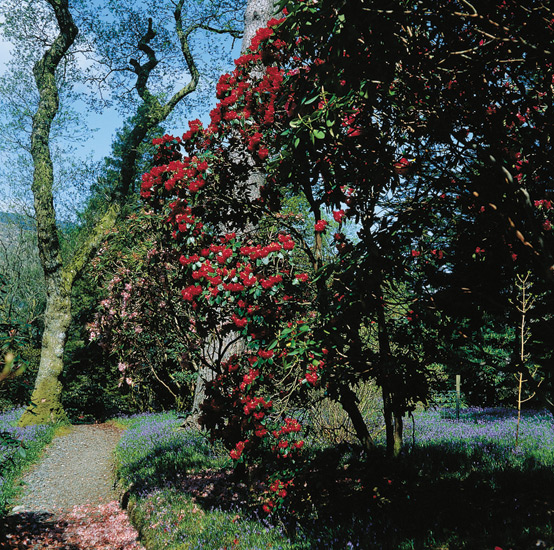
|
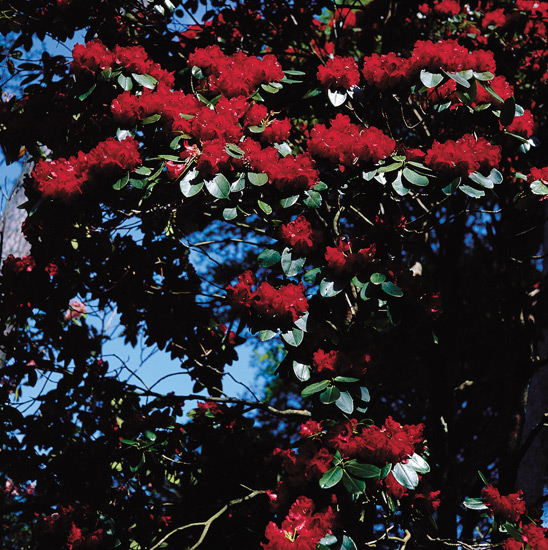
|
|
|
High up on Bodnant Bank is a
tree-like plant of the Aberconway cross
R. Orestes Group ( R. griersonianum x R. Shilsonii Group). A carpet of bluebells spreads throughout the Woodland Garden in early-May. Photo by John M. Hammond |
The
eye-catching deep blood-red flowers of R. Orestes Group
Photo by John M. Hammond |
On Sir John's death in 1938 he left the Estate to his three sons. John (1909- 1972) and Michael, the second and third sons respectively, decided to take on the Estate. Michael had run the Estate and the gardens at since the previous year and continued to do so until the on-set of WWII. It was decided that John would reside in Ardkinglas House and Michael would have a house constructed on another part of the Estate. Strone House was built in the late-1930s from plans said to have been drawn up by Robert Lorimer for a second house for the Estate and is located in a sentinel position overlooking Cairndow and Loch Fyne. Set in 14.83 acres of pastureland, between the Pinetum and the A83 road, the three-storey House with 21 rooms, constructed of stone with a slated roof, replaced an earlier farmhouse.
The outbreak of war appears to have delayed completion of the building. Michael and Anne commenced laying out and planting the gardens around Strone House itself in 1938, this being the third major garden to be developed on the Estate. As it is located above the Pinetum it is much more exposed to the winds and cold weather, but these climatic differences did not deter Michael and Anne from creating a 5-acre plantsman's garden around and below the House and putting down the 7-acre field above the House to conifer and broadleaf trees. Michael married Anne Pearson (b. 1923) in 1940 by which time he had taken-up service in the R.A.F. In the same year he placed orders for a significant selection of azaleas, rhododendrons and magnolias. G. Reuthe, Ltd., of Fox Hill Nurseries, Kent, supplied in November 1941 batches of one dozen R. augustinii , R. griersonianum and R. yunnanense ; one plant each of 'Loderi King George', 'Patience', 'Loderi Game Chick' and Venus Group; also two plants of R.'J.G. Millais'. 2 Knap Hill Nursery supplied 59 deciduous azaleas (Ghent, Knap Hill and Rustica Flore Pleno hybrids), 5 magnolias and 16 prunus and these were all delivered in June 1942 by which time there was a shortage of labour on the estate to plant them. 2 Most of the Loderi crosses appear to have been planted in the Pinetum, between the big trees and the car park, whilst Anne is said to have used most of the azaleas to create new beds in the lawn to the west of the terrace at Ardkinglas House.
In September 1945, when the R.H.S. Rhododendron Group was formed at the end of hostilities in Europe, Michael became a member of the Group. Then upon being demobilised from the R.A.F. in 1947 he moved his family into Strone House, took over the running of the Estate farm, looked after the gardens and his brother John looked after the Estate affairs. Sufficient progress with developing the Pinetum had been made for it to be opened to the public in 1948 as a woodland garden under the Scotland's Garden Scheme and in the same year Anne became the Scheme's District Organiser for Argyll, a role she continued until 1984. In 1948 the routine care and maintenance was still undertaken by the Head Forester and his staff in a manner consistent with that of traditional woodland plantation and policy.
It was around 1953 that Michael became engrossed in hybridisation, an interest that would surface whenever there was time in his busy life. A resume of his hybridisation goals and crosses appears below in this article. He had a small greenhouse where he also germinated seed from Himalayan expeditions; a tree fell on the greenhouse and demolished it, so a larger one was built.
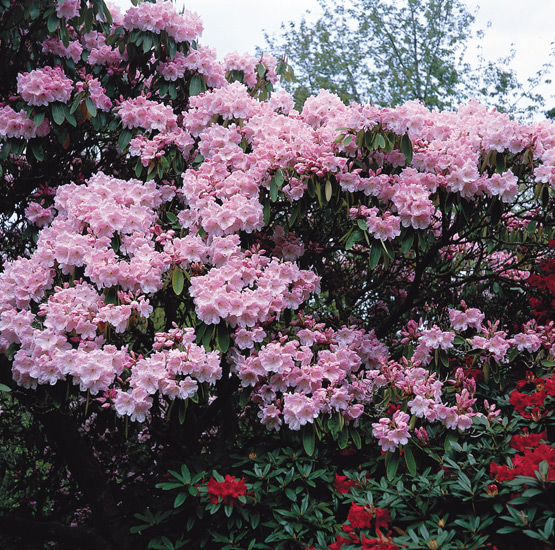
|
|
Across the road from
the upper levels of the Woodland Garden stands
Strone House, home of Michael Noble until 1984 and now a private residence. The garden still contains many good rhododendrons, including this impressive deep pink specimen of R. Venus Group. Photo by John M. Hammond |
Michael then became a competitor in the Scottish Rhododendron Show that was inaugurated in 1953 by a group of Scottish rhododendron enthusiasts and National Trust for Scotland (N.T.for S.) members who thought it appropriate that Scotland should have its own National Show. Organised by the Gardens Committee of the N.T.for S., the Show was a great success and the following year Ardkinglas Estate won the coveted Sir John Stirling Maxwell Trophy, awarded for the highest aggregate number of points in all classes. 21 By 1956 the R.H.S. appear to have realised that the rhododendron enthusiasts "North of the Border" were becoming organised and the competition needed to be taken seriously; at this date the only Scottish representation on the R.H.S. Rhododendron & Camellia Committee was Lord Strathcona & Mount Royal of Colonsay. From 1957 this Committee included a Scottish contingent, including Sir George Campbell of Crarae Lodge, Dr. J.M. Cowan of Inverewe House, Ewan H.M. Cox of Glendoick, Lord Elphinstone of Drumkilbo, Dr. H.R. Fletcher of R.G.B., Edinburgh, A.C. Gibson of Glenarn, Michael A.C. Noble of Strone and Earl of Stair of Lochinch Castle. A detailed report of the 1957 Scottish Show appeared for the first time in the R.H.S. Rhododendron and Camellia Year Book - 1958.
Michael was an outstandingly successful farmer and breeder; in due course he became president of both the Blackface Sheep Breeders Association and the Highland Cattle Society, and for nearly ten years served the Argyll County Council. In the mid-1950s he became interested in politics, probably as a result of the disenchantment caused by the poor relationship between Local Government and the farming community. In the 1958 Parliamentary General Election he won the Argyll seat for the Conservatives. Michael's intellectual vigour and deep sense of duty soon brought recognition, and, after being Government Chief Whip from 1960 to 1962, he was appointed Secretary of State for Scotland. During his all too short term of office, terminated by the Labour victory of 1964, he proved himself an outstanding success. The gruelling life of a Member of Parliament for the largest, and arguably the least populated, constituency in Britain, along with the responsibilities of a Cabinet Minister, inevitably led to less time being available for the garden, but Michael and Anne enjoyed working in their garden whenever they got the opportunity.
Ardkinglas Estate was divided in 1966 with Michael Noble having the 7,500-acre portion to the east of the Kinglas River. This portion became Strone Estate, which included Strone House, The Pinetum and Cairndow village with its unique octagonal Church. As a part of the division of lands The Pinetum was renamed Strone Woodland Garden. John S.B. Noble had Ardkinglas House and the property to the west of the Kinglas River. 2
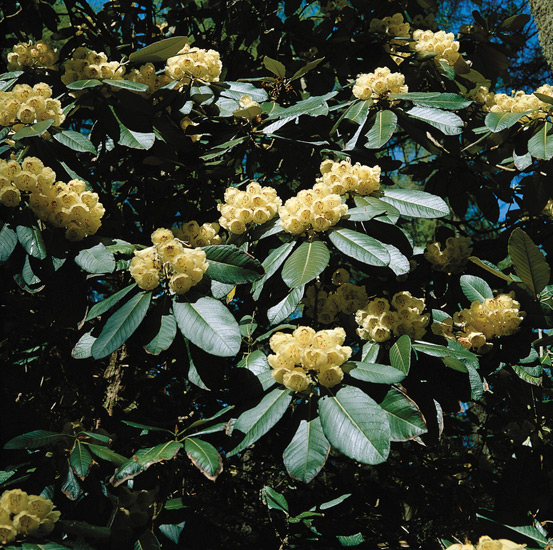
|

|
|
|
It is well worth
taking the time to search out the large-leaved species in
the Woodland Garden as many enthusiasts tend not to notice them. There are a number of good specimens including this R. macabeanum . Photo by John M. Hammond |
The flowers of 'Loderi Game
Chick' alongside
Primula pulverulenta
in a streamside drift is a reminder that many other types of plantings abound in the Woodland Garden. Photo by John M. Hammond |
In Conclusion
With the return of the Conservatives to power in 1970, Michael was appointed President of the Board of Trade, holding that office until it was done away with in the same year, when he became Minister of Trade until the Government fell in 1972. The first indications of an illness that was to become an ever-increasing burden made Michael decide that he would not fight the next election. Retirement from public life meant, of course, a return to farming, gardening and land management. It was a busy time for him and Anne, many improvements being carried out in both Strone Woodland and Strone House gardens - tree felling, cutting back, dead-wooding, clearing and burning, and in all of which their four daughters, sons-in-law, grandchildren and visitors were pressed into service!
On the death of John S.B. Noble in 1972 his son, Simon John (Johnny) Noble (1936-2002) inherited Ardkinglas Estate, along with some hefty debts. In 1967 Johnny had set-up a successful import wine business in the City of London and his passion for French wine received a significant setback when the business was sold after his father's death. On returning to Argyll he sought a means of re-invigorating the local economy that, in turn, would support the Estate, and perchance met Andrew Lane, a marine biologist, who suggested it would be viable to the create and farm oyster beds in the clear waters of Loch Fyne. They setup as business partners, despite being told at their first meeting with a "canny" local bank manager:
I suppose everyone must have a hobby, Mr. Noble.
In reality, Johnny Noble and Andrew Lane invested their own funds and raised the balance from private subscribers. So, in 1977, with a few hundred Portuguese oysters, they went into business.
In 1974 Michael was created a life peer as Baron Glenkinglas of Cairndow, and became a regular attendee in the House of Lords. He remained, until his death, one of the most brilliant bridge players in the Palace of Westminster. Lady Anne continued to take a keen interest in all the gardens at Strone and Ardkinglas. She was instrumental in the publication of Alan Mitchell's illustrated article "Big is Beautiful," dated June 8th, 1978, in the pages of Country Life. This confirmed that the woodland garden contains some of the finest specimen conifers in Britain, including five trees that were the tallest of their type in 1976, the Big Silver Fir ( Abies alba ) at 159ft., 3in., and 31ft., 3in. girth (48.5m x 952cm), an Alerce or Patagonian cypress ( Fitzroya cupressoides ) at 72ft., 3in. (22m), a Hinoki cypress ( Chamaecyparis obtuse ) at 63ft. (19m), a golden plumed sawara cypress ( Chamaecyparis pisifera ) at 66ft., 6in. (20.25m), a western red cedar ( Thuja plicata ) at 154ft., 4in. (47m), as well as the actual tallest tree in Britain, a grand fir ( Abies grandis ) at 210ft. (64m). Alan Mitchell also noted many other specimen trees of significant size and interest.
Though the progressive deterioration of Michael's health gradually cut down, to his great regret, his physical activity, his mind remained as clear as ever. Sir Ilay Campbell's eloquent words convey the thoughts of his many friends: 22 When the end came, it seemed appropriate that the azaleas and later rhododendrons should be in full bloom. At the funeral, the coffin, as it stood in the austerely beautiful octagonal Church at Cairndow, was adorned with some of Michael's favourites, including both 'Secretary of State' and 'Shadow Secretary', with 'Queen of Hearts' in delicate allusion to his skill at the bridge table! ...we mourn the passing of not only a great plantsman, but truly a man for all seasons.
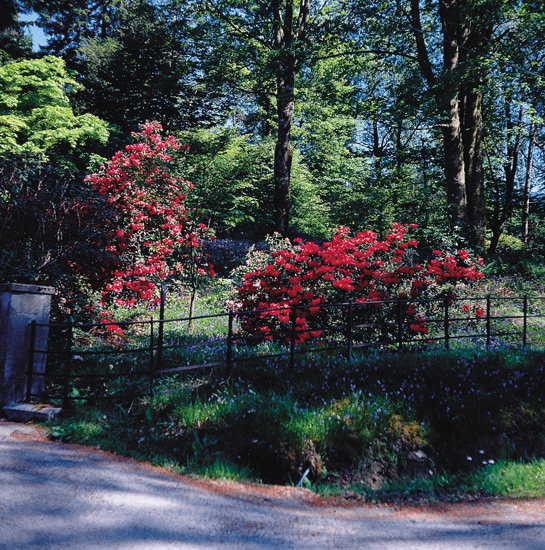
|
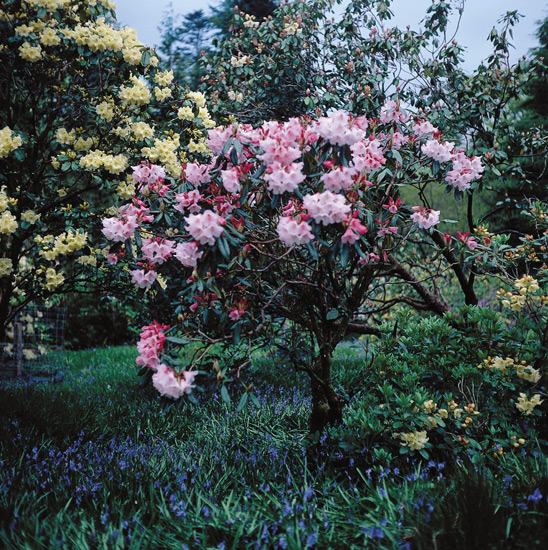
|
|
|
Strone House entrance
gate and driveway is lined with a wealth of
rhododendrons, including a few of Michael Noble's own hybrids. One the left is one of Noble's R. beanianum crosses and on the right is R. 'Gretia', a cross of R. Portia Group x R. griersonianum and a good example of one of the better Aberconway crosses that is not often seen. Photo by John M. Hammond |
Near the car park in the Woodland Garden
is a small grove of Michael Noble's hybrids. Photo by John M. Hammond |
Michael Noble left the Strone Estate to his four daughters, Catharine (Kate), Marya, Anastasia (Tuggy) and Rebecca, all of whom lived in the Southern England. The complications of joint ownership and their living at a distance from Cairndow led to Strone Woodland Garden becoming neglected; no replanting was done and this resulted in a corresponding fall in visitor numbers. And, just as Strone Woodland Garden had become mature it began to show the signs of reduced maintenance and slowly went to sleep. By the early-1990s the garden showed all the hallmarks of the lack of woodland management, the long-established ubiquitous sycamore ( Acer pseudoplatanus ), Rhododendron ponticum and bracken ( Pteridium aquilinum ). Intertwined bramble ( Rubus fruticosus ), pathological disorders, over-mature specimens and poor drainage made matters worse.
In 1993 the Strone Estate was put up for sale in eight separate lots, one of which was Stone Woodland Garden (advertised under its original name of "The Pinetum") and another lot was Strone House. Johnny Noble spearheaded the purchase of Strone Woodland Garden; that was then reunified within the Ardkinglas Estate policies and its name was quickly changed to Ardkinglas Woodland Garden. Johnny Noble's intention at the time of purchase is clear: 2 The woodland gardens in question contain some of the finest specimen conifers in the U.K. There are five which are the tallest of their type in Britain as well as the actual tallest tree in Britain. In addition there is a very mature collection of fine rhododendrons...A considerable effort and expense is required to put the garden back on the map as one of Argyll's, indeed one of Scotland's, premier gardens of its type; unrivalled for conifer specimens.
An immediate aim was a restoration of the garden to its former status and the following year David Gray, an ex-R.B.G.E. trainee, was appointed Head Gardener. Entirely by co-incidence, a timeframe for David to aim for fell into place by the author's decision in 1994 to include the garden in the tour programme for the 1996 American Rhododendron Society's Annual Convention to be based in Oban. David took forward a somewhat daunting work programme of grubbing-out, clearance of unwanted natural regenerated plants and trees, selected tree felling, lifting the canopy and clearance of drainage channels. By segregating the garden into compartments it was possible to prioritise those areas needing immediate attention and one by one, as compartments were cleared, it became possible to begin a programme of replanting. Inevitably, work could only proceed at a pace that financial budget of the Estate permitted. By early-2001 David had departed to take up new challenges on the Isle of Islay. Ian W.J. Sinclair, a very knowledgeable and experienced ex-Asst. Curator from the R.B.G.E.'s Benmore Garden, continued the renovation work at Ardkinglas for a couple of years prior to leaving to run a horticultural consultancy.
Meanwhile, Johnny Noble and his partner Andrew Lane had been successful in their "hands-on" attempt to pioneer the farming of oysters in the upper reaches of Loch Fyne. Within 25 years of founding the business they were selling worldwide 1.25 million oysters a year. They grew mussels on ropes in the loch and set up one of the finest oak-smoked ovens in Scotland catering for salmon, trout, langoustine and mussels. The smoked produce was exported all over the world and gained a superb reputation with the experts and public alike. In 1980 Johnny Noble opened an oyster bar at the head of Loch Fyne. Business boomed; the bar became a restaurant and a retail outlet was added. Loch Fyne Oyster restaurants can now be found in over 20 locations in Britain.
In May 2002 the author obtained agreement to explore the gardens at Strone House, bought by the Turnbull Family in 1993, to try and identify what "connections" exist between the plants in this garden and those at Ardkinglas House and in Ardkinglas Woodland Garden. Armed with Lady Anne's sketch-plan and her notes, this visit was a revelation in a number of ways, but in regard to Michael Noble's hybridisation work a number of seedlings were noted that appeared to be from the same orangey-red R. cinnabarinum cross. More than one has matured into an excellent garden plant, free from mildew problems, and would be well worth propagating. There are also what at first sight seem to be good examples of crosses referred to in Sir Ilay's notes; however, a number of visits at different times in the flowering season are needed to verify these suspicions. Initially, the sketch-plan of the garden did not make sense as the "nursery" area could not be found, that is, until it was realised that stock in the "nursery" had grown to fully mature plants that are still in the rows in which they had been originally set out! The plants are generally in a good condition and reflect the care and attention this garden has received from its "new" owners.
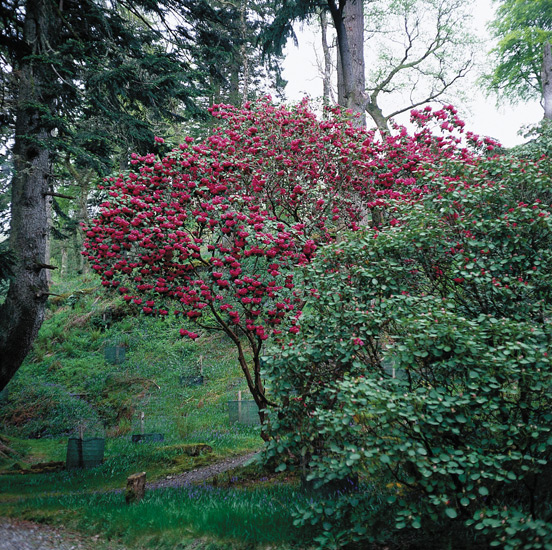
|
|
On the extreme left is
one of the four massive limbs of the Big Silver Fir (
Abies alba
),
each around 159 feet tall. This immense tree distracts many rhododendron enthusiasts who walk beneath the deep pink specimen of R. orbiculare without even noticing it. But then, who expects to see a plant of R. orbiculare that is over 20 feet tall? Photo by John M. Hammond |
Ardkinglas Woodland Garden is somewhat lost amidst the vast areas of woodland and forest that run down to the shores of Loch Fyne and are part of the large-scale timber investments made over the past 500 years, for amenity and economic purposes, by the branches of the Campbell Family. At Ardkinglas even rhododendron enthusiasts have difficulties "in seeing the wood for the trees" at times. They can be so entranced by the sight of the four-trunked "big silver fir" that they walk directly beneath the overhanging branches of a good deep-pink form of R. orbiculare in full flower, some 20 feet tall, without seeing it. But who expects to see a plant of R. orbicular e so tall? Inevitably, the heavy rainfall and damp temperate climate has a significant effect on the growth of plants as well as trees.
So, if you happen to be planning a springtime visit to Argyll and, perchance, after reaching the summit of the "Rest and be Thankful," you find your car gathering momentum as it skims down the long straight beside the waters of Glen Kinglas, remember to pull in the reins, take the left turn for Cairndow and follow the winding lane to another world. You'll be pleased you took the time to do so.
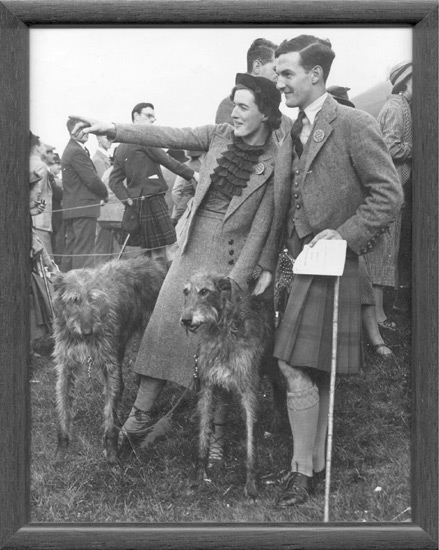
|
|
Michael Noble and his
sister Anastasia at the
Ardkinglas Sheep Trials in Cairndow village in about 1935. Photo courtesy of the Ardkinglas Estate |
The Hybridisation Work of Michael Noble
Henry MacLaren of Bodnant, later the 2nd Lord Aberconway, taught Michael Noble the fundamentals of rhododendron hybridisation and was responsible in no small measure for Michael interest. Michael's visits to Bodnant in the 1930s took place around the time when Lord Aberconway's hybridisation programme was at its zenith, and this must have had a major influence on the keen, young enthusiast. After Michael and Anne settled at Strone he turned his attention in the early-1950s to hybridisation, made numerous crosses and these were planted out in Strone garden and the Pinetum. When he had sufficient seed from these he passed the surplus to Sir George Campbell at Crarae; in Michael's view this "spread the risk." Sir George and his son Ilay germinated the seed and planted the resulting seedlings in groups in a particular area of the garden, the crosses and planting details being recorded in Sir George's notebook. Sir Ilay Campbell's notes of 1984 and 1995 provide a valuable insight to his aims and achievements: 25
Prior to Rhododendron hybridisation becoming a great interest at this period, and with the energy and ardour he put into anything he undertook, Michael set out, on the one hand, to increase the range of hardy (at any rate on Lochfyneside) hybrids of the subsections Maddenia and Edgeworthia, and on the other to prolong the rhododendron blooming season, producing late and early flowering red hybrids with attractive foliage.
The only really successful result, in the first category, was a cross between R. johnstoneanum and R. bullatum (now R. edgeworthii ) from seed sown in 1953. A mass of very variable seedlings resulted, flowering in 1956. Many were in no way superior to either parent, and some proved surprisingly tender, but a few were outstanding. The finest, registered in 1957 as R. 'John Bull', had pale pink flowers flushed with cream. In the second category, many distinguished hybrids were grown on at Strone, and at neighbouring Crarae. They may still be seen in both gardens. Among the early flowerers are R. strigillosum x R. meddianum , which, in a mild year, displays its large, deep red, waxy trusses in March, a very welcome harbinger of all the joys to come. For the later blooming crosses, such tender species as R. elliottii and R. eriogynum (now R. facetum ), were used as parents, with R. griersonianum and its hybrids.
In 1963, an outstanding plant in a group of crosses between R. griersonianum and R. 'Grosclaude' flowered at Crarae. Others of the "grex" had flowered before, all good bright reds, in habit tending to be straggly, but the selected clone shows strong upward growth, the leaves with a dusting of cinnamon indumentum, the blood red flowers in large regular trusses. It was registered in 1965, and given the name R. 'Secretary of State', as this was the post occupied by the breeder at that date!
The following year, in late-may, an even more spectacular hybrid, resulting from a somewhat unlikely alliance between R. elliottii and R. 'Sarita Loder', flowered. It had huge trusses of what the R.H.S. Handbook calls "signal red," but which the layman might more easily visualise as "geranium," borne against shiny foliage, the individual leaves up to ten inches long. It was registered in 1966 when the Conservatives were in Opposition and was, therefore, given the clonal name of R. 'Shadow Secretary', though there was, and is, nothing shadowy about it!
No further crosses made by Michael have been registered, although many have proved excellent garden plants. R. strigillosum x R. forrestii Repens Group makes a compact bun-shaped bush, though unfortunately its scarlet (in some cases pink) flowers are very frost tender in bud, while, at the other end of the scale, are two deep red R. haematodes crosses with R. 'Break of Day' and R. 'Fabia'. R. 'Jan Steen' x R. 'May Day' produces cream flowers distinctly striped with coral pink, while R. 'May Day' x R. 'Ivanhoe' is vivid pillar box red, each corolla having sharply pointed lobes.
Others again, notably the many crosses made using R. campylocarpum , R. souliei and R. wardii provide annually, what Michael himself termed "good background music."
I would imagine that all these and probably more, as we did not receive seed of all the crosses made, are planted at Strone or in the Arboretum, but how many are labelled or recorded I don't know. Most of our groups can be identified from the planting plan, and some are labelled.
Athough rhododendrons remained his best loved genus, R. cerasinum , the cinnarbarinum hybrids, Sherriff 's R. wardii , being his favourites; Michael and Anne after grew many other genera successfully.
R. 'John Bull' was registered by Michael in 1957. However, Sir Ilay's notes do not mention R. 'Harriet' ( R. racemosum x R. ciliatum ) also registered in 1957 and the progeny from this pale pink cross are thought to have formed the hedge that ran along the Strone House lawn. R. 'Secretary of State' and R. 'Shadow Secretary' were registered by Sir George Campbell. A check of the pages of Sir George Campbell's notebook reveal that seed from 82 crosses were planted out at Crarae. Little is known of Michael's hybridisation work with deciduous azaleas other than he made crosses between the products of Exbury and Knap Hill. A number were selected for evaluation and some of these still exist in the gardens of Strone House, but none have been named, whilst the surplus was sold on Scotland's Garden Scheme "Open Days" for 2s/6d each.
Acknowledgements
The author is particularly grateful to the late-Johnny Noble of Ardkinglas, who permitted access to old family documents from the Estate records during research work to unravel details of the development of the gardens; to David Sumsion who inherited Ardkinglas Estate in 2002 and has continued to support this project, to Jean Maskell, Estate Office Manager of Ardkinglas, for her help over many years and to Jonny Turnbull for graciously allowing access to Strone House garden. The author is also indebted to David Gray, past-Head Gardener on the Estate, who provided access to copies of documents compiled with the Lady Anne's help during his own researches in connection with the arboricultural history of the Woodland Garden, and to my long-time friend Ian W.J. Sinclair, also past-Head Gardener on the Estate, for his help and advice. These acknowledgements would be incomplete without due recognition of the use of documents and information provided by Sir Ilay Campbell, who is the only remaining direct link with the hybridisation work of Michael Noble.
References
1. Campbell, Niall Diarmid. 1905. Letter to Tenantry of Ardkinglas.
2. Ardkinglas Estate. 1905–1996. Estate records and documents relating
to Ardkinglas House, gardens and woodlands.
3. Atholl, Duke of. 1908. Chronicles of the Atholl Family. Published privately.
Vol. 1, p 265.
4. MacFarlane, Walter. 1906-08. Ane Descriptione of certaine pairts of the Highlands
of Scotland; MacFarlane's Geographical Collections. Scottish History Society (Edinburgh).
Vol. 2: 144-146.
5. Hammond, John M. 2001. The Development of the Gardens and Design Landscape of
Gargunnock House. Scottish Rhododendron Society, Yearbook No. 4, 2001: 9-18.
6. Foster, P. & Simpson, D.H. 1999. Whitton Park and Whitton Place. Borough
of Twickenham Local History Society. Paper No.41, 1999.
7. Brett-James, Norman G. 1925. Life of Peter Collinson. Dunstan.
8. Lindsay, Ian J. & Cosh, Mary. 1973. Inveraray and the Dukes of Argyll.
Edinburgh University Press, Edinburgh.
9. Transactions of the Linnean Society, 1811; 275.
10. Walpole, Horace. 1782. The History of Modern Taste in Gardening.
Ursus Press, New York. (Reprinted 1995).
11. Campbell, Sir James. 1832. Memoirs of Sir James Campbell, of
Ardkinglas. Henry Colburn and Richard Bentley, London.
12. MacDonald, Murdo. c1998. Ardkinglas Antics. Argyll & Bute Local
History. Argyll & Bute Council. Issue 2.
13. Campbell, Niall Diarmid. 1901-1902. Personal Diaries. Inveraray Castle
Archives, courtesy 12th Duke of Argyll.
14. Argyll, 12th Duke of. 1996. Correspondence to David Gray, Head
Gardener at Ardkinglas. November, 1996.
15. Maclean, Charles and Sykes, Christopher Simon. 1992. Scottish Country.
Clarkson N. Potter, Inc., New York.
16. Ardkinglas, Argyllshire, A Seat of Sir Andrew Noble, Bt., K.C.B. Country Life.
May 27th, 1911: 746-754.
17. Kernan, Caroline. 1998. Ardkinglas, Loch Fyne, May 1998. Garden History
Society Newsletter (London). No.54, Winter, 1998.
18. Mitchell, Alan. 1978. Big is Beautiful: A Scottish Collection of Large
Conifers. Country Life June 8, 1978.
19. Wilkie, Thomas. 1881. Old and Remarkable Trees on the Estate of Ardkinglas,
Argyleshire. Scottish Arboricultural Society Vol.IX: 169.
20. Gray, David. 1999. Ardkinglas Woodland Garden. Scottish Forestry.
Journal of the Royal Scottish Forestry Society. Vol.54, No.2 (2000).
21. Douglas, Ian. 2004. The Sir John Stirling Maxwell Trophy. Scottish
Rhododendron Society, Newsletter. No.59, Winter, 2004: 20-22.
22. Campbell, Sir Ilay. 1984. Lord Glenkinglas. Manuscript of an obituary
sent to the R.H.S. Journal. 1984.
23. Lowes, Kenneth. 1987. The garden at Strone, Argyll. R.H.S. Rhododendrons
with Magnolias and Camellias. 1987: 3-12.
24. Aberconway, Lord. 1996. Correspondence to David Gray, Head Gardener at
Ardkinglas. 1996.
25. Campbell, Sir George and Sir Ilay. 1986-2004. Letters and documents relating
to the rhododendron crosses made by Michael Noble.
